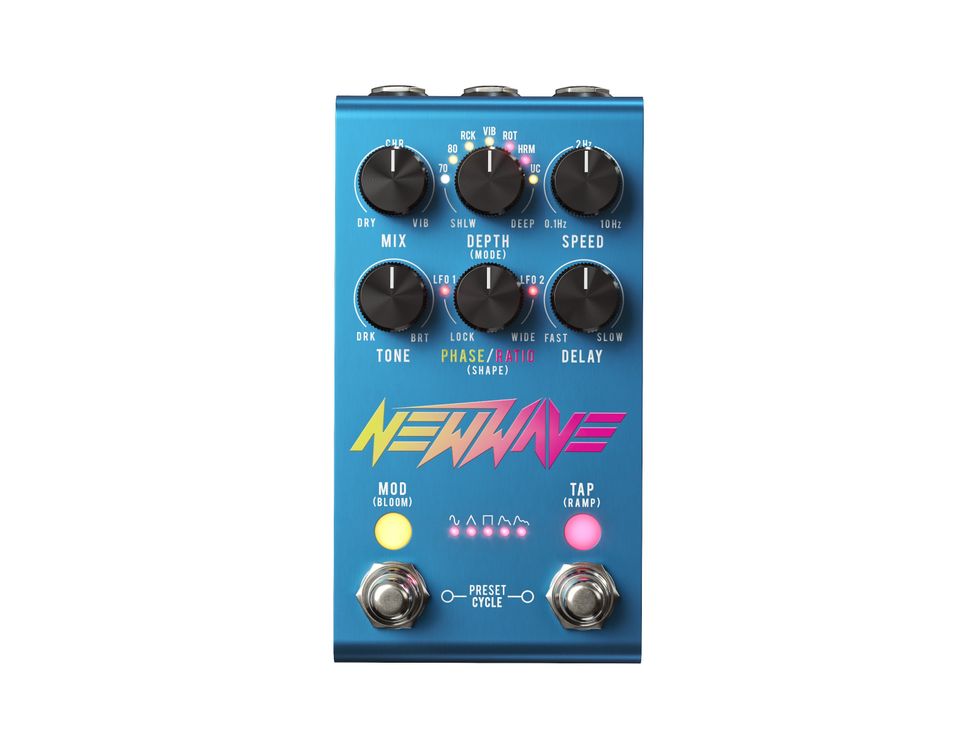
In my modulation universe, I think of chorus as the North Star—the effect around every other modulation effect turns. Within it, you hear traces of delay, phase, and reverb all mixed together to create waves of sound that evoke powerful and often very specific feelings and musical settings. Sometimes that feeling is the lush sound of ’80s pop. Other times it can be aggressive and unnerving. Jackson Audio’s New Wave, a chorus/vibrato collaboration with Snarky Puppy’s Mark Lettieri, aims to cover both of those extremes and nearly everything in between.
Join The Chorus
The centerpiece of the New Wave’s control set is the depth knob, which also cycles through the pedal’s seven different modes when you push it. On either side you have a mix control that can take you from fully dry to fully wet, and a speed control that ranges from 0.1 Hz to 10 Hz. The second row of controls features a tone knob, phase/ratio knob (which doubles as a wave shape selector when pushed), and a delay control.
Anytime I test out a chorus pedal, my go-to combo is a T-style guitar and the opening chord of The Police’s “Walking on the Moon.” (Yes, Andy Summers used a flanger, but you get the idea). The 70 setting is the only mono mode in the New Wave, and the simplicity of the sound shines through when playing vintage-style tunes. With all knobs at noon I was impressed with the dimension and richness in the sound. And the sensitive depth and speed knobs enabled me to fine tune the delicate balance that makes a perfect chorus sound. Maxing out the depth while minimizing the speed gave me a beautiful, full sound that, with the right mix, could be compared to a very fluid, modulated reverb. Doing the inverse pushes you into ring modulation territory.
The 80 mode has two LFO signals working together to create ever so subtle pitch-shifting, generating a flowing sense of uneasiness that’s hard to nail in digital emulations. In addition to the other modes, which include rack, vibrato, rotary, harmonic chorus, and user control (a deep dive into these would take up much more than the space allowed for this review), you have five different LFO shapes that range from traditional sine to the rhythmically driving triplet solina. One of my favorite settings combines the harmonic mode with the triangle LFO, which you can hear in the accompanying audio online. It’s great for adding interesting textures to otherwise unremarkable melodic lines and making them into compelling riffs.
Other headline features on the New Wave include ramp and bloom switches that are built into the bypass and tap tempo options. With the bloom mode engaged you automatically fade in and fade out the effect when you hit the bypass switch—a welcome feature that makes the New Wave fit more seamlessly into songs where the effect appears periodically. Also, you can control the speed of the effect via an expression pedal or the ramp footswitch, which functions much like the slow/fast switch on a Leslie.
The Verdict
The New Wave is far more than a simple chorus machine. Brad Jackson, Mark Lettieri, and the team at Jackson Audio created a unit that gathers up the chorus effect’s greatest hits from the last 40-plus years and adds crafty ways to manipulate them and incorporate them into modern, more nuanced arrangements. The tones are rich. And the wealth of options tells me that serious thought and care went into developing the core functions and the extras that make it feel so flexible. Yes, there is a bit of a learning curve as you sort out the ways that all the controls interact with each other. But the reward is unlocking a wide array of dreamy, disgusting, and droning sounds that you won’t find readily in most chorus devices.
From Your Site Articles
Related Articles Around the Web









